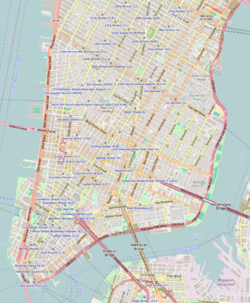Bowling Green (New York City)
|
Bowling Green Fence and Park
|
|

Bowling Green in a composite photograph taken from the steps of the U.S. Custom House looking north
|
|
| Location | Southern end of Broadway, New York City |
|---|---|
| Coordinates | 40°42′18″N 74°0′49″W / 40.70500°N 74.01361°WCoordinates: 40°42′18″N 74°0′49″W / 40.70500°N 74.01361°W |
| Built | 1733 |
| NRHP Reference # | 80002673 |
| Added to NRHP | April 9, 1980 |
Bowling Green is a small public park in the Financial District of Lower Manhattan, New York City, at the southern end of Broadway, next to the site of the original Dutch fort of New Amsterdam. Built in 1733, originally including a bowling green, it is the oldest public park in New York City and is surrounded by its original 18th-century fence. The iconic Charging Bull sculpture is exhibited on its northern end.
Bowling Green Fence and Park is listed on the U.S. National Register of Historic Places. It is abutted by Battery Park to the west.
The park has long been a center of activity in the city going back to the days of New Amsterdam, when it served as a cattle market between 1638 and 1647, and parade ground. In 1675, the Common Council designated the "plaine afore the forte" for an annual market of "graine, cattle and other produce of the country". In 1677 the city's first public well was dug in front of Fort Amsterdam at Bowling Green. In 1733, the Common Council leased a portion of the parade grounds to three prominent neighboring landlords for a peppercorn a year, upon their promise to create a park that would be "the delight of the Inhabitants of the City" and add to its "Beauty and Ornament"; the improvements were to include a "bowling green" with "walks therein". The surrounding streets were not paved with cobblestones until 1744.
On August 21, 1770, the British government erected a 4,000 pound (1,800 kg) gilded lead equestrian statue of King George III in Bowling Green; the King was dressed in Roman garb in the style of the Equestrian Statue of Marcus Aurelius. The statue had been commissioned in 1766, along with a statue of William Pitt, from the prominent London sculptor Joseph Wilton, as a celebration of victory after the Seven Years' War. With the rapid deterioration of relations with the mother country after 1770, the statue became a magnet for the Bowling Green protests; in 1773, the city passed an anti-graffiti and anti-desecration law to counter vandalism against the monument, and a protective cast-iron fence, which still stands, was built along the perimeter of the park.
...
Wikipedia



